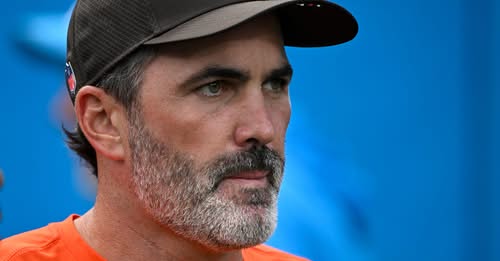The Cleveland Browns find themselves in a quarterback conundrum that is rapidly capturing the attention of NFL fans across the country. With Shedeur Sanders, Kenny Pickett, and Joe Flacco all unavailable, head coach Kevin Stefanski has made the surprising decision to hold off on starting Dillon Gabriel, leading the team to reportedly explore signing a seventh quarterback. This development has sent shockwaves through the NFL community, as fans and analysts scramble to understand the implications for the Browns’ roster, strategy, and season outlook.
The situation is remarkable not only for its rarity but also for the sheer number of quarterbacks the Browns are now juggling. Most NFL teams enter the season with a clear hierarchy at the position, usually anchored by a veteran starter and a capable backup. Cleveland, however, is navigating a scenario that few franchises have experienced: a fluid quarterback roster that could soon include seven players at the position. For NFL observers, this has become a story of roster management, risk mitigation, and strategic decision-making under unusual circumstances.Kevin Stefanski, known for his methodical approach and calm demeanor, faces a uniquely challenging situation. Normally, a coach would lean on the depth chart to determine the starter in any given week, but with Sanders, Pickett, and Flacco sidelined, the decision is far from straightforward. Dillon Gabriel, who has shown promise in practice and possesses a strong arm and mobility, might have seemed the logical choice to step into the starting role. Yet Stefanski’s decision to hold off indicates a careful, perhaps cautious, approach that weighs multiple factors beyond raw talent.
Reports suggest that the Browns are not merely reacting to injuries but are actively considering long-term strategy. By bringing in a seventh quarterback, the team is signaling an interest in maintaining depth, flexibility, and insurance against further unforeseen setbacks. In an era when quarterback injuries can derail seasons almost overnight, having multiple options is increasingly viewed as prudent management. The move also underscores how the NFL has evolved in terms of quarterback valuation, with teams willing to allocate roster spots to ensure continuity and reduce risk.
For fans, the news has sparked a flurry of reactions on social media, sports forums, and sports talk radio. Many are expressing shock, some amusement, and others frustration. Comments range from incredulous takes like, “Seven quarterbacks? Are they building a football team or hosting a quarterback convention?” to more analytical discussions about how the team plans to manage reps, practice time, and game-day readiness. Analysts have weighed in as well, noting that the Browns’ approach could become a case study in quarterback management, particularly if the newly signed player is thrust into meaningful snaps.
The Browns’ quarterback carousel also raises questions about team chemistry and offensive cohesion. Quarterbacks must build rapport with receivers, understand timing with the offensive line, and master the playbook in a way that allows them to make quick, decisive reads under pressure. Introducing yet another quarterback into the mix complicates this process, particularly mid-season or during a stretch of consecutive games. Stefanski will have to balance maintaining competitive readiness with ensuring that any new player is integrated effectively without disrupting established routines.
This is not the first time the Browns have faced quarterback uncertainty, but the scale of the current situation is unprecedented. Over the past decade, the franchise has experienced periods of instability at the position, cycling through starters, backups, and short-term solutions. While injuries are a perennial concern in the NFL, the convergence of multiple absences and the need for an additional quarterback highlights the fragility of the roster and the importance of depth in a position that is arguably the most critical on the field.
Dillon Gabriel’s role is particularly intriguing in this context. As a quarterback with starting potential, Gabriel represents both an opportunity and a challenge. He has the skill set to lead an offense and deliver consistent production, yet Stefanski’s hesitation suggests a careful assessment of readiness, matchup considerations, and perhaps even game-plan compatibility. This raises questions about the evaluation metrics coaches use when deciding whether to start a quarterback. Beyond arm strength and accuracy, decision-making, leadership, pocket presence, and situational awareness all play pivotal roles in determining whether a player is deemed ready to step into a starting role under high-pressure circumstances.
Shedeur Sanders’ absence adds another layer of complexity. As a highly touted rookie quarterback with significant hype and expectations, Sanders carries not only physical talent but also a narrative that the organization must manage. Sitting a promising player can have implications for confidence, morale, and public perception. However, rushing a rookie into action before he is fully prepared can be equally damaging. Stefanski’s choice to delay Sanders’ debut reflects a balance between immediate team needs and long-term development, an approach increasingly favored by teams investing in young quarterback talent.
Kenny Pickett and Joe Flacco’s unavailability compounds the dilemma. Pickett, who has had moments of promise but also inconsistency, represents a bridge option between development and production. Flacco, the seasoned veteran, brings leadership and experience but is also at a stage in his career where physical limitations and performance variability must be considered. Their simultaneous absence leaves a significant void in experience and stability, pushing the Browns to consider creative solutions.
The NFL has seen other teams navigate unusual quarterback situations, but Cleveland’s potential seventh QB scenario is rare. Historical precedents show that teams with extensive quarterback turnover often struggle with continuity, offensive rhythm, and performance consistency. Coaches must make careful calculations about practice reps, game-day active rosters, and emergency contingency plans. In some cases, teams have resorted to signing free agents or even practice squad players on short notice, highlighting the unpredictable nature of the position.
Fan engagement around the situation has been intense. Social media has exploded with speculation about who the seventh quarterback might be, how they will fit into the system, and whether this move signals a shift in the Browns’ season strategy. Memes, jokes, and analytical threads abound, illustrating the unique intersection of sports fandom and digital culture. For many, the scenario is both bewildering and entertaining, providing a rare storyline that extends beyond wins and losses to the mechanics of roster management and coaching decision-making.
The Browns’ front office also deserves attention in this context. As much as Stefanski’s decisions are under scrutiny, the executive team’s ability to scout, sign, and integrate an additional quarterback is critical. Roster management in the NFL involves not only evaluating talent but also navigating salary cap implications, contractual obligations, and long-term development plans. Bringing in a seventh quarterback requires coordination across multiple departments, highlighting the collaborative nature of modern NFL operations.
Strategically, the move to consider another quarterback offers several advantages. It ensures depth in case of further injuries, provides a platform for competition that could elevate performance, and offers a degree of tactical flexibility in game planning. Conversely, it carries risks, including potential disruption of team chemistry, dilution of practice reps, and the possibility that the new quarterback may not be fully prepared for game action. Balancing these factors is a delicate art, and Stefanski’s decision-making in the coming days will be closely scrutinized by both fans and analysts.
The Browns’ offense, built around a mix of passing and rushing schemes, requires precision, timing, and decision-making at the quarterback position. Any disruption in continuity can affect not only the quarterback but also the offensive line, receivers, and overall game rhythm. Integrating a new quarterback mid-season, particularly one who may not have had extensive preparation with the first-team offense, is a challenging task. Coaches must adjust practice plans, simplify schemes if necessary, and monitor player reactions to ensure cohesion.
Looking ahead, the decision to delay Dillon Gabriel’s start while signing an additional quarterback could influence the trajectory of the Browns’ season. A carefully chosen addition might stabilize the position, provide insurance against further injuries, and allow Stefanski to maintain offensive efficiency. Alternatively, if the move is mishandled, it could exacerbate instability and lead to inconsistent performance. Either outcome will offer lessons for other NFL teams facing quarterback depth challenges in the future.
In conclusion, the Cleveland Browns’ exploration of a seventh quarterback amid the absence of Shedeur Sanders, Kenny Pickett, and Joe Flacco represents a rare and compelling scenario in modern NFL football. Kevin Stefanski’s cautious approach to starting Dillon Gabriel underscores the complexity of quarterback management, balancing immediate needs with long-term development. Fans and analysts alike are watching closely, dissecting every decision, social media post, and rumor as the Browns navigate this unusual landscape. The situation highlights not only the critical importance of depth at the quarterback position but also the strategic, psychological, and operational considerations that coaches and front offices must manage in a league defined by high stakes and rapid change. As the season progresses, the outcome of this decision will likely be remembered as a defining moment in Cleveland Browns history, offering insights into the evolving art of roster management and the intricate dynamics of quarterback strategy in the NFL.



